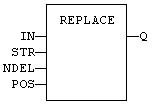
![]() A function calculates a result according to the current value of its inputs. A function has no internal data and is not linked to declared instances. - Replace characters in a string.
A function calculates a result according to the current value of its inputs. A function has no internal data and is not linked to declared instances. - Replace characters in a string.
Inputs
|
Inputs |
Data Type |
Description |
|---|---|---|
|
IN |
STRING |
Character string. |
|
STR |
STRING |
String containing the characters to be inserted in place of NDEL removed characters. |
|
NDEL |
DINT |
Number of characters to be deleted before insertion of STR. |
|
POS |
DINT |
Position where characters are replaced (first character position is 1). |
Outputs
| Output | Data Type | Description |
|---|---|---|
|
Q |
STRING |
Modified string. |
Remarks
- The first valid character position is 1.
- In the FFLD language, the operation
is executed only if the input rung (EN) is TRUE.
- The output rung (ENO) keeps the same value as the input rung.
- In the IL
 "Instruction list"
This is a low-level language and resembles assembly language, the first input (the string) must be
loaded in the current result before calling the function.
"Instruction list"
This is a low-level language and resembles assembly language, the first input (the string) must be
loaded in the current result before calling the function. - Other arguments are operands of the function separated by comas.
ST Language
Q := REPLACE (IN, STR, NDEL, POS);
FBD Language
FFLD Language
(* The function is executed only if EN is TRUE *)
(* ENO keeps the same value as EN *)

IL Language
Op1: LD"Ladder diagram" Ladder logic is a method of drawing electrical logic schematics. It is now a very popular graphical language for programming Programmable Logic Controllers (PLCs). It was originally invented to describe logic made from relays. The name is based on the observation that programs in this language resemble ladders, with two vertical "rails" and a series of horizontal "rungs" between them IN
REPLACE STR, NDEL, POS
ST Q
See Also







